BA4008QA - Business Decision Making: Statistics & Project Analysis
VerifiedAdded on 2023/06/18
|9
|1055
|342
Homework Assignment
AI Summary
This assignment focuses on business decision-making, employing descriptive statistics, regression analysis, and project management techniques. It includes tasks such as calculating and interpreting descriptive statistics for UK Netflix viewers' age data, analyzing frequency distributions, and comparing different methods of calculation. Furthermore, the assignment delves into regression analysis to predict employee separation based on factors like hourly pay and weekly hours. It also covers project management concepts, including critical path analysis. The document concludes with a self-reflection on the student's strengths and challenges encountered during the assignment, emphasizing the importance of accurate calculations and critical analysis in statistical decision-making. Desklib provides a platform for students to access similar solved assignments and past papers for further learning.
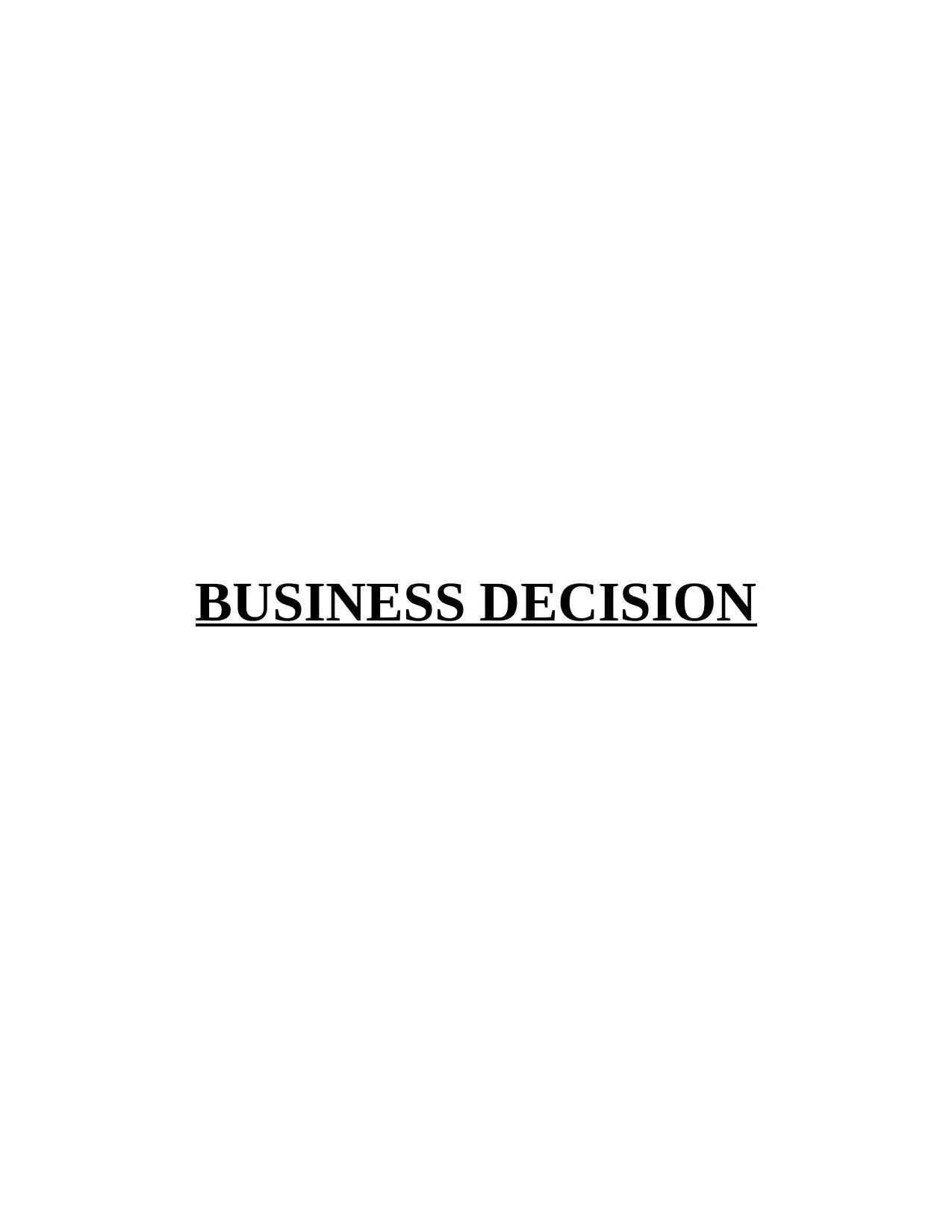
BUSINESS DECISION
Paraphrase This Document
Need a fresh take? Get an instant paraphrase of this document with our AI Paraphraser

Table of Contents
TASK-1............................................................................................................................................2
Question 1)...................................................................................................................................2
Question 2)...................................................................................................................................2
TASK-2............................................................................................................................................2
Question 1)...................................................................................................................................2
Question 2)...................................................................................................................................3
Question 3)...................................................................................................................................3
Question 4)...................................................................................................................................3
TASK-3............................................................................................................................................4
Question 1)...................................................................................................................................4
Question 2)...................................................................................................................................4
Question 3)...................................................................................................................................4
Question 4)...................................................................................................................................4
TASK-4............................................................................................................................................5
Question 1)...................................................................................................................................5
Question 2)...................................................................................................................................5
Question 3)...................................................................................................................................5
TASK-5............................................................................................................................................5
Question 1)...................................................................................................................................5
Question 2)...................................................................................................................................5
Question 3)...................................................................................................................................6
REFERENCES................................................................................................................................6
1
TASK-1............................................................................................................................................2
Question 1)...................................................................................................................................2
Question 2)...................................................................................................................................2
TASK-2............................................................................................................................................2
Question 1)...................................................................................................................................2
Question 2)...................................................................................................................................3
Question 3)...................................................................................................................................3
Question 4)...................................................................................................................................3
TASK-3............................................................................................................................................4
Question 1)...................................................................................................................................4
Question 2)...................................................................................................................................4
Question 3)...................................................................................................................................4
Question 4)...................................................................................................................................4
TASK-4............................................................................................................................................5
Question 1)...................................................................................................................................5
Question 2)...................................................................................................................................5
Question 3)...................................................................................................................................5
TASK-5............................................................................................................................................5
Question 1)...................................................................................................................................5
Question 2)...................................................................................................................................5
Question 3)...................................................................................................................................6
REFERENCES................................................................................................................................6
1
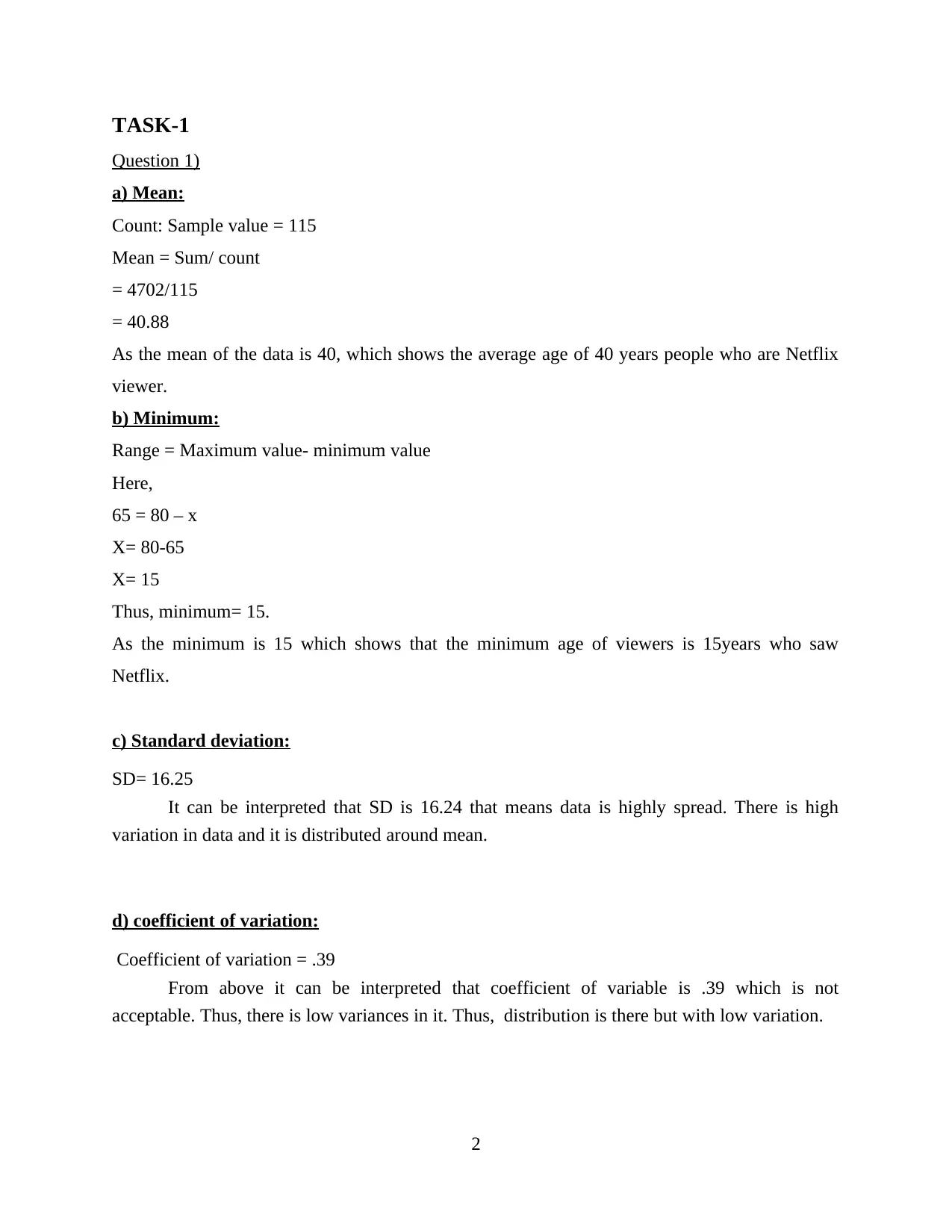
TASK-1
Question 1)
a) Mean:
Count: Sample value = 115
Mean = Sum/ count
= 4702/115
= 40.88
As the mean of the data is 40, which shows the average age of 40 years people who are Netflix
viewer.
b) Minimum:
Range = Maximum value- minimum value
Here,
65 = 80 – x
X= 80-65
X= 15
Thus, minimum= 15.
As the minimum is 15 which shows that the minimum age of viewers is 15years who saw
Netflix.
c) Standard deviation:
SD= 16.25
It can be interpreted that SD is 16.24 that means data is highly spread. There is high
variation in data and it is distributed around mean.
d) coefficient of variation:
Coefficient of variation = .39
From above it can be interpreted that coefficient of variable is .39 which is not
acceptable. Thus, there is low variances in it. Thus, distribution is there but with low variation.
2
Question 1)
a) Mean:
Count: Sample value = 115
Mean = Sum/ count
= 4702/115
= 40.88
As the mean of the data is 40, which shows the average age of 40 years people who are Netflix
viewer.
b) Minimum:
Range = Maximum value- minimum value
Here,
65 = 80 – x
X= 80-65
X= 15
Thus, minimum= 15.
As the minimum is 15 which shows that the minimum age of viewers is 15years who saw
Netflix.
c) Standard deviation:
SD= 16.25
It can be interpreted that SD is 16.24 that means data is highly spread. There is high
variation in data and it is distributed around mean.
d) coefficient of variation:
Coefficient of variation = .39
From above it can be interpreted that coefficient of variable is .39 which is not
acceptable. Thus, there is low variances in it. Thus, distribution is there but with low variation.
2
⊘ This is a preview!⊘
Do you want full access?
Subscribe today to unlock all pages.

Trusted by 1+ million students worldwide
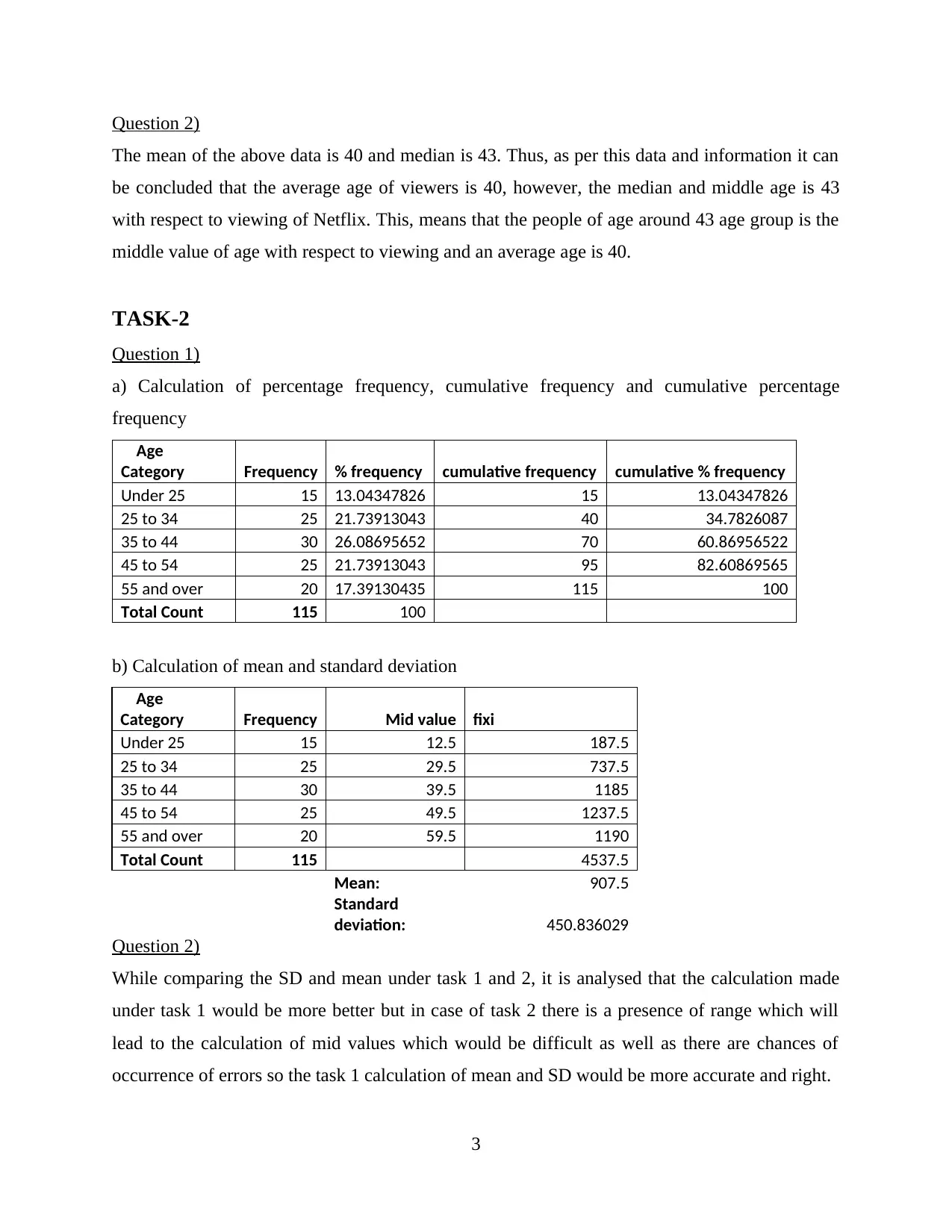
Question 2)
The mean of the above data is 40 and median is 43. Thus, as per this data and information it can
be concluded that the average age of viewers is 40, however, the median and middle age is 43
with respect to viewing of Netflix. This, means that the people of age around 43 age group is the
middle value of age with respect to viewing and an average age is 40.
TASK-2
Question 1)
a) Calculation of percentage frequency, cumulative frequency and cumulative percentage
frequency
Age
Category Frequency % frequency cumulative frequency cumulative % frequency
Under 25 15 13.04347826 15 13.04347826
25 to 34 25 21.73913043 40 34.7826087
35 to 44 30 26.08695652 70 60.86956522
45 to 54 25 21.73913043 95 82.60869565
55 and over 20 17.39130435 115 100
Total Count 115 100
b) Calculation of mean and standard deviation
Age
Category Frequency Mid value fixi
Under 25 15 12.5 187.5
25 to 34 25 29.5 737.5
35 to 44 30 39.5 1185
45 to 54 25 49.5 1237.5
55 and over 20 59.5 1190
Total Count 115 4537.5
Mean: 907.5
Standard
deviation: 450.836029
Question 2)
While comparing the SD and mean under task 1 and 2, it is analysed that the calculation made
under task 1 would be more better but in case of task 2 there is a presence of range which will
lead to the calculation of mid values which would be difficult as well as there are chances of
occurrence of errors so the task 1 calculation of mean and SD would be more accurate and right.
3
The mean of the above data is 40 and median is 43. Thus, as per this data and information it can
be concluded that the average age of viewers is 40, however, the median and middle age is 43
with respect to viewing of Netflix. This, means that the people of age around 43 age group is the
middle value of age with respect to viewing and an average age is 40.
TASK-2
Question 1)
a) Calculation of percentage frequency, cumulative frequency and cumulative percentage
frequency
Age
Category Frequency % frequency cumulative frequency cumulative % frequency
Under 25 15 13.04347826 15 13.04347826
25 to 34 25 21.73913043 40 34.7826087
35 to 44 30 26.08695652 70 60.86956522
45 to 54 25 21.73913043 95 82.60869565
55 and over 20 17.39130435 115 100
Total Count 115 100
b) Calculation of mean and standard deviation
Age
Category Frequency Mid value fixi
Under 25 15 12.5 187.5
25 to 34 25 29.5 737.5
35 to 44 30 39.5 1185
45 to 54 25 49.5 1237.5
55 and over 20 59.5 1190
Total Count 115 4537.5
Mean: 907.5
Standard
deviation: 450.836029
Question 2)
While comparing the SD and mean under task 1 and 2, it is analysed that the calculation made
under task 1 would be more better but in case of task 2 there is a presence of range which will
lead to the calculation of mid values which would be difficult as well as there are chances of
occurrence of errors so the task 1 calculation of mean and SD would be more accurate and right.
3
Paraphrase This Document
Need a fresh take? Get an instant paraphrase of this document with our AI Paraphraser
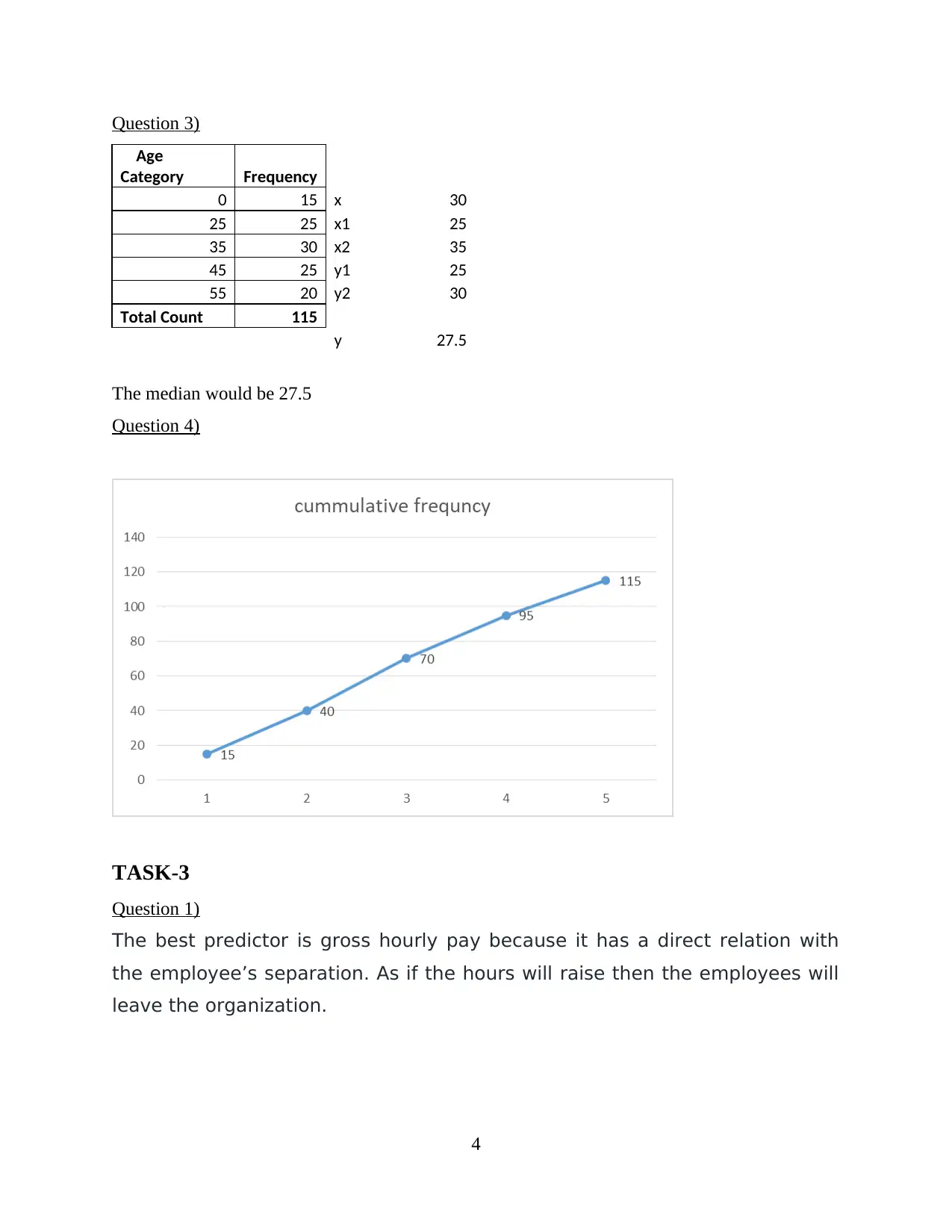
Question 3)
Age
Category Frequency
0 15 x 30
25 25 x1 25
35 30 x2 35
45 25 y1 25
55 20 y2 30
Total Count 115
y 27.5
The median would be 27.5
Question 4)
TASK-3
Question 1)
The best predictor is gross hourly pay because it has a direct relation with
the employee’s separation. As if the hours will raise then the employees will
leave the organization.
4
Age
Category Frequency
0 15 x 30
25 25 x1 25
35 30 x2 35
45 25 y1 25
55 20 y2 30
Total Count 115
y 27.5
The median would be 27.5
Question 4)
TASK-3
Question 1)
The best predictor is gross hourly pay because it has a direct relation with
the employee’s separation. As if the hours will raise then the employees will
leave the organization.
4
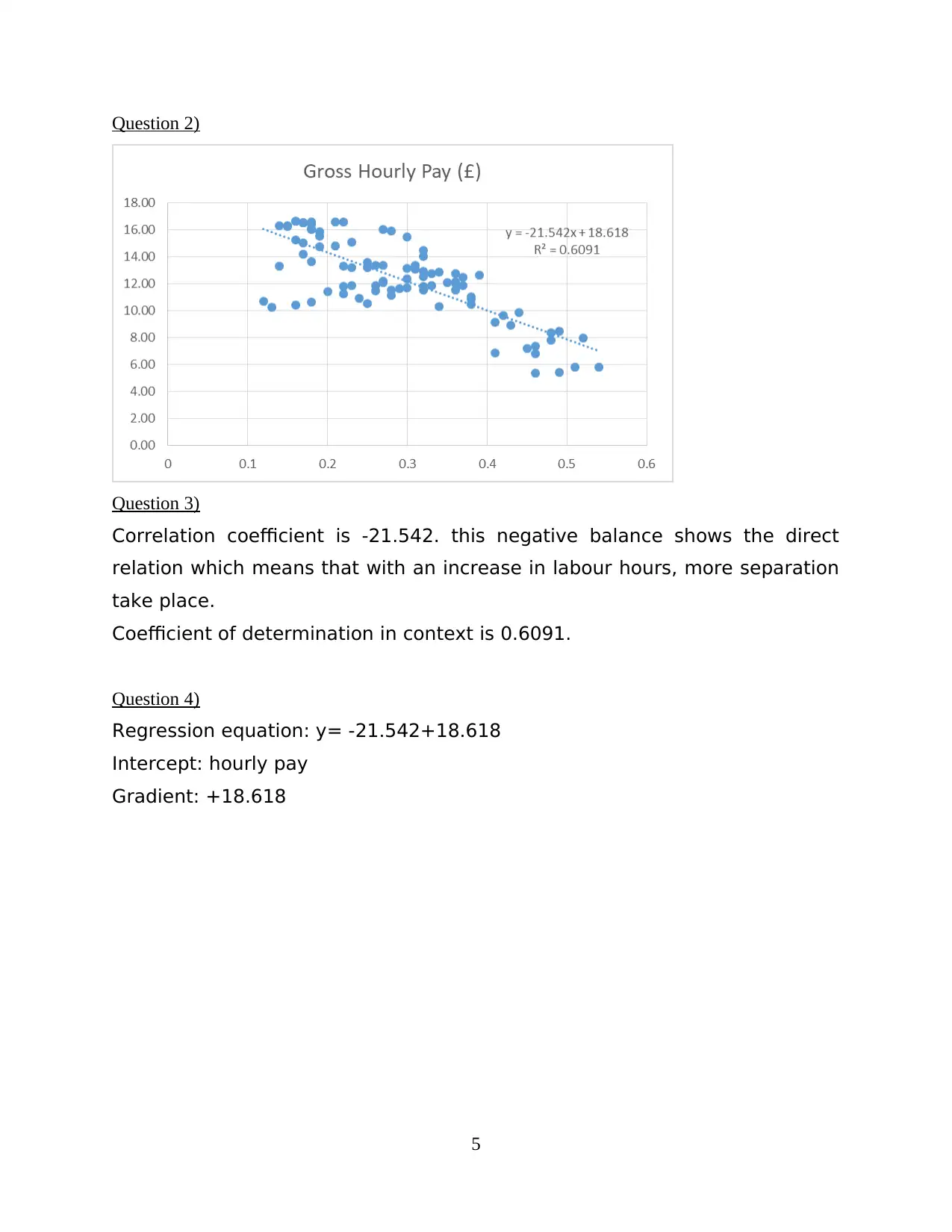
Question 2)
Question 3)
Correlation coefficient is -21.542. this negative balance shows the direct
relation which means that with an increase in labour hours, more separation
take place.
Coefficient of determination in context is 0.6091.
Question 4)
Regression equation: y= -21.542+18.618
Intercept: hourly pay
Gradient: +18.618
5
Question 3)
Correlation coefficient is -21.542. this negative balance shows the direct
relation which means that with an increase in labour hours, more separation
take place.
Coefficient of determination in context is 0.6091.
Question 4)
Regression equation: y= -21.542+18.618
Intercept: hourly pay
Gradient: +18.618
5
⊘ This is a preview!⊘
Do you want full access?
Subscribe today to unlock all pages.

Trusted by 1+ million students worldwide

TASK-4
Question 1)
Question 2)
The critical path is A, B, D and F because here the duration is low i.e. 21 weeks. The duration of
entire project is 33 weeks.
Question 3)
Critical activities includes scheduled activities that is a part of critical path which will take place
within a project. However, in case of non-critical activities the activities can be pushed beyond
the deadline and it have no impact over the project.
TASK-5
Question 1)
I particularly well the calculation and the understanding regarding the various concepts and
aspects of statistics. As statistics leads to decision making (BOMBACI BILGIN, Bulger and
Fung, 2020). So this is also well presented by me. Under this assignment I made well with regard
to making of graphs and calculation along with its interpretation with the given context. I also
made critical analysis of the concept very well.
Question 2)
The most challenging aspect was the interpretation and calculation part (Søbjerg and et.al.,
2020). This is because a slight mistake in the calculation of the figures will lead to have the
entire wrong interpretation. As the calculation is the base of statistics so it is most challenging as
well as important aspect for me.
6
Question 1)
Question 2)
The critical path is A, B, D and F because here the duration is low i.e. 21 weeks. The duration of
entire project is 33 weeks.
Question 3)
Critical activities includes scheduled activities that is a part of critical path which will take place
within a project. However, in case of non-critical activities the activities can be pushed beyond
the deadline and it have no impact over the project.
TASK-5
Question 1)
I particularly well the calculation and the understanding regarding the various concepts and
aspects of statistics. As statistics leads to decision making (BOMBACI BILGIN, Bulger and
Fung, 2020). So this is also well presented by me. Under this assignment I made well with regard
to making of graphs and calculation along with its interpretation with the given context. I also
made critical analysis of the concept very well.
Question 2)
The most challenging aspect was the interpretation and calculation part (Søbjerg and et.al.,
2020). This is because a slight mistake in the calculation of the figures will lead to have the
entire wrong interpretation. As the calculation is the base of statistics so it is most challenging as
well as important aspect for me.
6
Paraphrase This Document
Need a fresh take? Get an instant paraphrase of this document with our AI Paraphraser
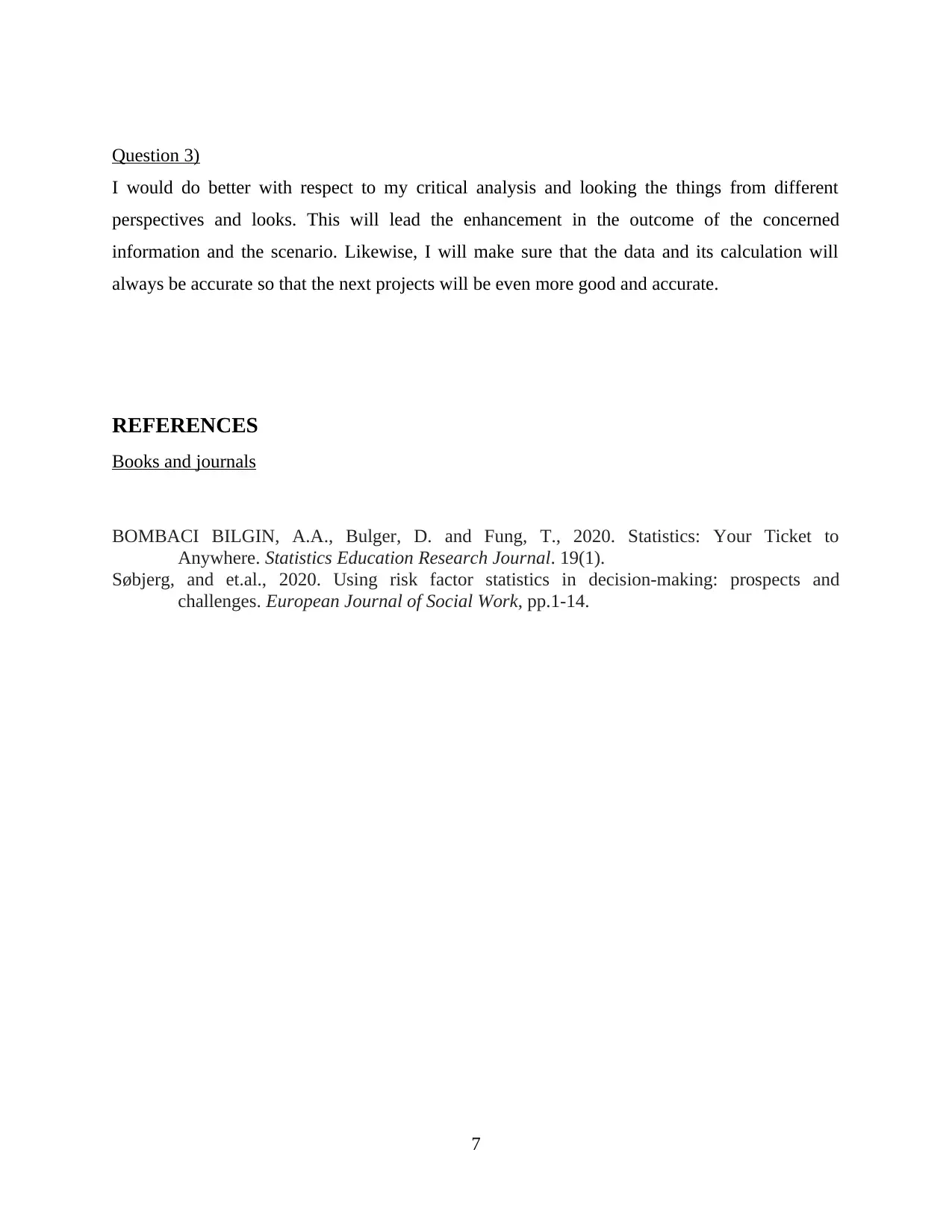
Question 3)
I would do better with respect to my critical analysis and looking the things from different
perspectives and looks. This will lead the enhancement in the outcome of the concerned
information and the scenario. Likewise, I will make sure that the data and its calculation will
always be accurate so that the next projects will be even more good and accurate.
REFERENCES
Books and journals
BOMBACI BILGIN, A.A., Bulger, D. and Fung, T., 2020. Statistics: Your Ticket to
Anywhere. Statistics Education Research Journal. 19(1).
Søbjerg, and et.al., 2020. Using risk factor statistics in decision-making: prospects and
challenges. European Journal of Social Work, pp.1-14.
7
I would do better with respect to my critical analysis and looking the things from different
perspectives and looks. This will lead the enhancement in the outcome of the concerned
information and the scenario. Likewise, I will make sure that the data and its calculation will
always be accurate so that the next projects will be even more good and accurate.
REFERENCES
Books and journals
BOMBACI BILGIN, A.A., Bulger, D. and Fung, T., 2020. Statistics: Your Ticket to
Anywhere. Statistics Education Research Journal. 19(1).
Søbjerg, and et.al., 2020. Using risk factor statistics in decision-making: prospects and
challenges. European Journal of Social Work, pp.1-14.
7

8
⊘ This is a preview!⊘
Do you want full access?
Subscribe today to unlock all pages.

Trusted by 1+ million students worldwide
1 out of 9
Related Documents
Your All-in-One AI-Powered Toolkit for Academic Success.
+13062052269
info@desklib.com
Available 24*7 on WhatsApp / Email
![[object Object]](/_next/static/media/star-bottom.7253800d.svg)
Unlock your academic potential
Copyright © 2020–2025 A2Z Services. All Rights Reserved. Developed and managed by ZUCOL.





